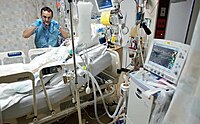
Photo from wikipedia
Lungs and kidneys are two vital and frequently injured organs among critically ill patients. In this study, we attempt to develop a weaning prediction model for patients with both respiratory… Click to show full abstract
Lungs and kidneys are two vital and frequently injured organs among critically ill patients. In this study, we attempt to develop a weaning prediction model for patients with both respiratory and renal failure using an explainable machine learning (XML) approach. We used the eICU collaborative research database, which contained data from 335 ICUs across the United States. Four ML models, including XGBoost, GBM, AdaBoost, and RF, were used, with weaning prediction and feature windows, both at 48 h. The model’s explanations were presented at the domain, feature, and individual levels by leveraging various techniques, including cumulative feature importance, the partial dependence plot (PDP), the Shapley additive explanations (SHAP) plot, and local explanation with the local interpretable model-agnostic explanations (LIME). We enrolled 1789 critically ill ventilated patients requiring hemodialysis, and 42.8% (765/1789) of them were weaned successfully from mechanical ventilation. The accuracies in XGBoost and GBM were better than those in the other models. The discriminative characteristics of six key features used to predict weaning were demonstrated through the application of the SHAP and PDP plots. By utilizing LIME, we were able to provide an explanation of the predicted probabilities and the associated reasoning for successful weaning on an individual level. In conclusion, we used an XML approach to establish a weaning prediction model in critically ill ventilated patients requiring hemodialysis.
Journal Title: Healthcare
Year Published: 2023
Link to full text (if available)
Share on Social Media: Sign Up to like & get
recommendations!